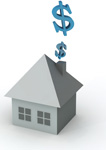Intro to "Calculate the Net Profitability of your Rental Income Property"
Try the calculator Calculate the Net Profitability of your Rental Income Property? >
Buy to rent; evaluating your real estate investment
 Buying a real estate property with the goal of renting it is a common investment that can insure a constant cash flow of income. However, even though it is a popular type of investment, when looking at the numbers, it is actually comparable to any other type of investment such as the stock market, government titles or other business project.
Buying a real estate property with the goal of renting it is a common investment that can insure a constant cash flow of income. However, even though it is a popular type of investment, when looking at the numbers, it is actually comparable to any other type of investment such as the stock market, government titles or other business project.
The following simulator will help you calculate the potential financial outcome of your investment property (net of taxes) which could then be used to compare it to other investment opportunities. However, this calculator cannot measure more qualitative aspects such as the relevant expertise required to run the business, which could favor this form of investment over others.
Income and expenses of a rental property
Managing financially a rental property is comparable to any other business; you have a start-up cost which will later on generate income and expenses, and ultimately create a profit, or a loss. You will also need to take into consideration the capital gain or loss when you resell the real estate asset, hoping that, like any other stock market purchase or business, you bought it at a good price to start off, in order to resell it at a higher price later on.
This type of real estate project requires an initial investment: the cash down on the mortgage balance, the acquisition costs (notary/lawyer fees, inspection) and the disbursements needed for renovations, if any. For the investor, this initial cost is considered the purchase price of the project which will then generate income from rent and other services, but also current and capital expenses.
Current expenses are the costs related to normal operations such as the cost of utilities, insurance, property taxes, repairs and maintenance. All these expenses are tax-deductable. It is important to differentiate the difference between cost of repairs and capital expenses on a real estate asset. Repair costs are current expenses which maintain the property in good condition in the short term (painting the walls for example). Capital expenses, on the other hand, are disbursements made for additions or improvements to the property (installing new windows for example).
Capital expenses aim to increase the value of the property. They are considered an investment with the objective of creating higher revenue in the long run, while current expenses are made to maintain the revenue. Capital expenses are not tax-deductable, instead, they reduce the tax load when included in the depreciation and amortization expenses.
If the rental property is resold, there will be a capital gain or loss, depending on the level of appreciation or depreciation of the real estate asset. Some expenses directly related to the sale are tax-deductable on capital gain, such as realtor fees and closing mortgage costs. There are two different taxes applied when a real estate asset is resold; one on the depreciation recapture, and the other one on the capital gain.
All the revenue and expenses enumerated above are quantifiable and should be included in your analysis. It is important to measure the performance of a rental property investment, studying its rate of return, or net present value, so it can be compared with the performance of other potential types of investments.
Taxes and depreciation
There are strong similarities between countries when it comes to tax application, only the tax rate and type of depreciation on rental real estate differs. The following calculator takes into account your country's regulations, giving you the choice to insert the tax rate bracket and the type of depreciation (see reference on type of depreciation for countries). Our financial simulator executes the calculation automatically, but to better understand the taxes' laws and depreciation mechanism, here is an explanation:
In a financial report, we include an annual depreciation expense (tax-deductable) related to the purchase, with the addition of improvements of the real estate asset. It is not a real cash disbursement, but it is added as an expense in order to reduce the tax load. In other words, it offers a tax break to encourage capital investments. The annual depreciation amount is calculated by spreading the purchase cost of the property and other capital expenses over many years.
There are two main types of depreciation used for real estate assets: straight line and declining balance, but only one per country is adopted. The calculator provides you with the option to select one or the other, but note that only the asset and its related costs are taken into account in the depreciation calculation. The land and its related costs are never considered as a depreciable asset.
In the case of a declining balance, the annual depreciation expense is calculated by applying the depreciation rate on the purchase cost. The following year, the same rate is applied on the new depreciated balance. Let's take Canada's rate of 4% as an example:
| Purchase cost: $100,000.00 | Depreciation rate: 4% |
|---|---|
| Calculation of the annual depreciation charge: | |
| 1st year: | 100,000 X 4% = $4,000.00 |
| 2nd year: | (100,000 – 4,000) X 4% = $3,840.00 |
| 3rd year | (96,000 – 3,840) X 4% = $3,686.00 |
In the declining balance calculation, as seen above, the depreciation expense cannot be the main cause of an annual loss. The amount that you are allowed to put in your financial results is the minimum between the official rate, and the rate that would bring the profit before tax to zero.
The straight-line depreciation stays unchanged every year and is calculated by dividing the purchase cost with the amount of years it can be depreciated. The annual depreciation is equal every year, and stops being declared when it surpasses the limited period it can be depreciated. Let's take the United States at 27.5 years and France at 20 years as an example.
| Purchase cost: $100,000.00 | USA | France |
|---|---|---|
| Annual depreciation: | 100 000 / 27.5 | 100 000 / 20 |
| 1st year: | 3 636 | 5 000 |
| 2nd year: | 3 636 | 5 000 |
| (...): | 3 636 | 5 000 |
| 20th year: | 3 636 | 5 000 |
| 21st year: | 3 636 | - |
| (...): | 3 636 | - |
| 28th year: | 1 818 | - |
| 29th year: | - | - |
| Total depreciation: | $100,000.00 | $100,000.00 |
It is important to consider, however, that this tax break will come back to you when reselling the real estate asset, as you included the depreciation expenses in your financial results. Governments will demand to be repaid from the tax savings you benefited in the past. This is called depreciation recapture and the tax rate applied is similar to the one applied earlier on the gross profit.
There is a different rate applicable on the capital gain, and most governments only ask for half of the normal rate. This calculator gives you the possibility to specify the rate on capital gain.
If your real estate asset end ups losing value over time then there will be no tax on the capital loss and the depreciation recapture will not be the same. The rate is applied on the difference between the selling price (as opposed to the purchase price which is lower), and the new depreciated balance, which helps reduce the tax load.
In this analysis we take into consideration that the purchase of the property is done on day 0 of the fiscal year, which allows us to declare a complete first year of depreciation. Finally, the tax rate is applied on the loss during deficit years, which helps decrease the tax load for the following year.
Return on investment
We can calculate the return on investment by comparing the cumulated profit with the initial investment, allowing us to see the profit generated by the original investment. It is very useful in the eyes of the investor because it shows the performance of the initial investment and evaluates the opportunity cost.
For example, if an initial investment of $100,000.00 generates a cumulated profit of $121,000.00 after two years, the return on investment is 10%, which we can see in the following example:
| Initial investment: | $100,000.00 | ||
| Scenario: | A | B | C |
|---|---|---|---|
| Profit on the 1st year: | -11 000 | 24 000 | 75 000 |
| Profit on the 2nd year: | 130 000 | 97 000 | 46 000 |
| Cumulated profit: | 121 000 | 121 000 | 121 000 |
| Return on investment: | 10% | 10% | 10% |
| Calculation: | $100,000.00 X (1+10%)2 = $121,000.00 | ||
As we can see in the chart, this calculation does not take into consideration the cash flow in time. The return on investment is 10%, no matter what profits are recorded on the first and second year, as long as their addition totals $121,000.00. To integrate the notion of money in time, we have to work with the net present value.
Net present value (NPV) and internal rate of return (IRR)
A rental property will likely have a different cash flow every year. For this reason, it is important to discount each annual profit respectively to its cashing year. To get a present value of all future cash flows, we discount the annual profit based on the cashing year, and use one specific rate of return.
By subtracting the initial investment from the total discounted cash flow, you obtain the net present value (NPV). If the result is positive, it means you recorded a higher rate of return than you expected. If it's negative, the rate of return is then lower than the one you expected. See below an example with an initial investment of $100,000.00:
| Required rate of return: | 10% | 7,32% | 5% | ||
| Year | Cash flow | NPV negative | NPV nil | NPV positive | Calculation |
|---|---|---|---|---|---|
| 0 | (100 000) | (100 000) | (100 000) | (100 000) | |
| 1 | 1 000 | 909 | 932 | 952 | Cash flow / (1+rate)1 |
| 2 | 15 000 | 12 397 | 13 024 | 13 605 | Cash flow / (1+rate)2 |
| 3 | 30 000 | 22 539 | 24 273 | 25 915 | Cash flow / (1+rate)3 |
| 4 | 40 000 | 27 321 | 30 157 | 32 908 | Cash flow / (1+rate)4 |
| 5 | 45 000 | 27 941 | 31 614 | 35 259 | Cash flow / (1+rate)5 |
| NPV | 31 000 | (8 893) | 0 | 8 640 | |
When you invest an amount hoping to cash a higher amount in the future, you’re integrating the notion of rate of return. When you discount and summarize all the amounts you plan to cash within the years to come, (based on one single interest rate) you can then obtain the amount you need to invest today. In other words, you can measure how long it will take for you to reimburse your initial investment, based on the rate of return.
When your net present value is zero, you discover the project's internal rate of return (IRR). In our example, the IRR is 7.32%. This means that you will be able to totally reimburse your initial investment at a rate of return of 7.32% over 5 years. The NPV and IRR will give us a measuring tool to compare with other investments or business projects that have a variable annual cash flow.
Using the calculator
Even though investing in rental properties is popular, a low rate can mean that it would have been better to invest in the stock market, government titles or other business projects, and sometimes for a lot less effort.
This calculator will help you make a good financial projection of your next rental property purchase and measure the potential of its net profitability for a specific period of years. You could also evaluate when you will totally reimburse your initial investment. It is free, very accurate and easy to use. However, it won't take into consideration the more qualitative aspects which can involve, for example, the management of the rental property and reparations & renovations that you might do yourself. This calculator will help you evaluate the outcome of your real estate project, and assist you to see where your investment can lead.
Try the calculator Calculate the Net Profitability of your Rental Income Property? >




